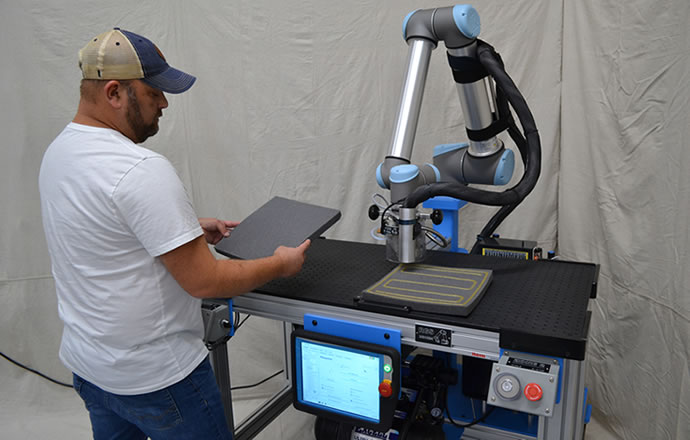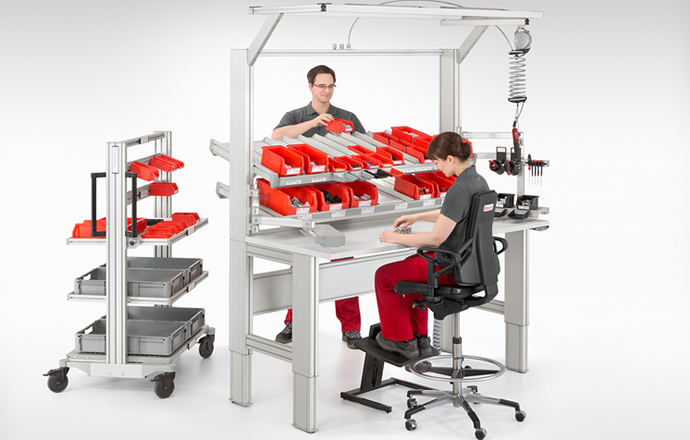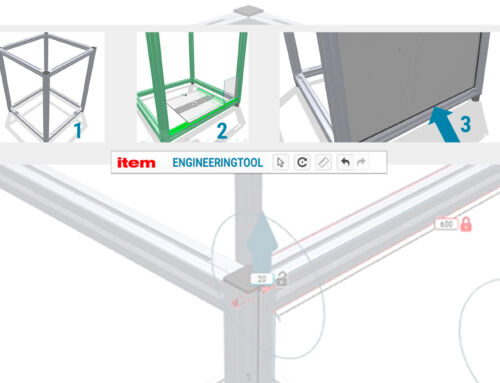ESD damage may be invisible to the naked eye, but it can have very costly consequences. That’s why following the basics of ESD safety is an absolute must for many industrial companies.
Virtually everyone has been caught off guard by a sudden jolt – that momentary electric shock you get when shaking someone’s hand or touching a metal door handle or banister. These are all cases of an electrostatic discharge (ESD) with a voltage of up to 3500 volts – they may hurt, but they’re harmless to humans. However, the same cannot be said for electronic components, for which a charge of just 100 volts would be enough to wipe information from a magnetic data storage device or destroy an EPROM electronic memory cell. But despite the risk ESD poses to electronic components, many companies tasked with manufacturing and further processing these very parts often overlook the basics of ESD safety.
What does ESD mean?
ESD stands for “electrostatic discharge” and describes an uncontrolled equalization of electrical charges between two objects charged with different voltages. An electrostatic discharge of this kind does not even require direct contact.
This poses a clear problem for industry, as electronic components can be damaged by ESD at any point in the production chain, especially seeing as electrostatic charges are essentially continuously being generated – through friction and movement, for example. Even just working at a work bench can create a charge of up to 6000 volts.
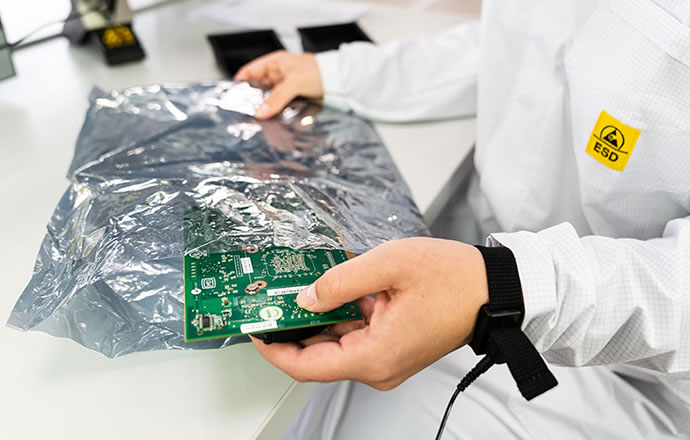
antistatic bags protect esd-sensitive components during transport.
This is where ESD presents yet another problem. Although we notice many everyday examples of electrostatic discharge because of the pain we experience – when shaking hands, for example – ESD can often go completely undetected, too. This is because discharges of this kind can only be felt at 3500 volts or higher.
Nevertheless, sensitive components can still be damaged when exposed to much lower voltages. For example, when manufacturing magnetic hard disks, a charge of just 5 volts is enough to damage the sensitive read head. This is aggravated by the fact that electrostatic discharges don’t just come from humans. Factory equipment, such as transport trolleys, tools and working surfaces, can also become electrostatically charged and cause ESD damage – unless it has been specially designed with ESD safety in mind.
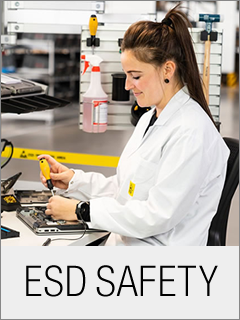 Interested in learning more?
Interested in learning more?
Download the free item Case Study!
.ESD safety – the basics for industry
However, it’s not just the discharge itself that often goes unnoticed – the resulting damage, such as damaged conductors, cannot be detected with the naked eye, either. Even an optical microscope is not enough in most cases, meaning an electron microscope is usually required to make ESD damage visible. The resulting failures don’t occur until a few weeks or months afterwards when the end customer is using the product. The consequences for the affected companies then become apparent all the more quickly, with complaints, expensive warranty payouts and a loss of customer trust. ESD is therefore a kind of worst-case scenario for any company, as the damage can be done while the part is still with the supplier and go unnoticed in the company’s own manufacturing plant.

esd damage like this flash-over current path is only visible through an electron microscope.
Fortunately, ESD damage can be effectively avoided if companies are aware of the issue and consistently put the basics of ESD safety into practice. To achieve this, it is vital that ESD safety is understood and established as a company-wide concept. What’s more, ESD safety has to begin as early as the supplier selection stage and continue until the product has been safely handed over to the customer. There is even a standard for establishing ESD safety as a holistic company practice – DIN EN 61340-5-1. It prescribes an ESD control programme that sets out the key components of an ESD safety concept in such a way that they are mandatory for all staff and that encompasses the following areas and duties:
- Compliance with the relevant standards
- Documented protection procedures for the entire process chain (incl. suppliers and customers)
- Standard-compliant protective clothing
- Well-trained ESD coordinators and staff
- ESD-protected areas set up as per industry standards
- Daily inspections of relevant aspects
- Compliance with personal protective provisions
- Regular internal audits
The basics of ESD safety
A properly equipped workforce is therefore essential to ensuring effective ESD safety. However, employees must also be made aware of the importance of ESD-safe accessories and how to use them. ESD training can help explain the issue to staff and teach them the basics of ESD safety and how to adhere to them. That said, it’s certainly not enough to only train the employees tasked with processing electronic components. Comprehensive ESD safety is only possible if it is actively pursued by all staff members – regardless of whether they’re cleaners, technicians or warehouse staff.
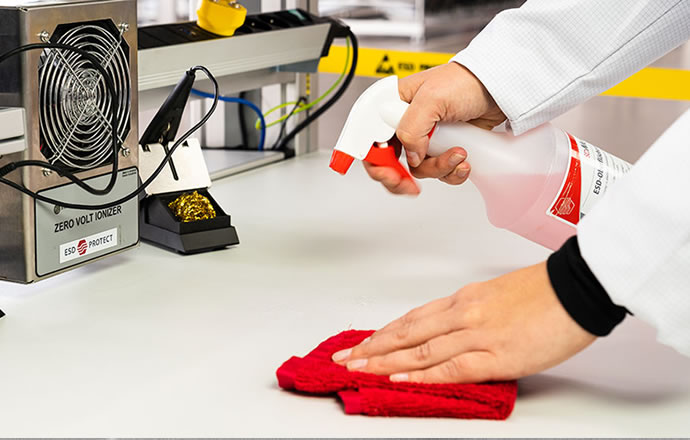
so as not to compromise the dissipative/conductive qualities of specially coated esd surfaces, they must be cleaned with special esd surface cleaners.
Besides factors such as suitable protective clothing, special tools for preventing ESD and compliance with relevant standards, the ambient humidity also plays an important role in comprehensive ESD safety. After all, low humidity levels facilitate the build-up of electrostatic charges. That’s why the palpable discharges we experience in everyday life occur much more frequently in the winter months. It is therefore important, when dealing with electronic components, to keep the relative humidity to at least 30 % in the areas requiring protection, if the building structure allows for this. Materials delivered by suppliers that exhibit different electrostatic charges present a further ESD risk. Such differences can be equalized as the goods arrive, using ionizers, for example, before the material reaches intralogistics operations.
Factory equipment & EPA – the basics of ESD safety in practice
The DIN standard also prescribes suitably equipped electrostatic protected areas (EPAs) as part of the basics of ESD safety. Electronic components may only be handled or assembled in these areas. The fundamental thinking behind EPAs is that all material used within them needs to be electrostatically dissipative and earthed to the same potential. This makes it possible to reliably avoid electrostatic charges and differences in potential. An EPA can consist of a single work bench, a set area or even an entire building.
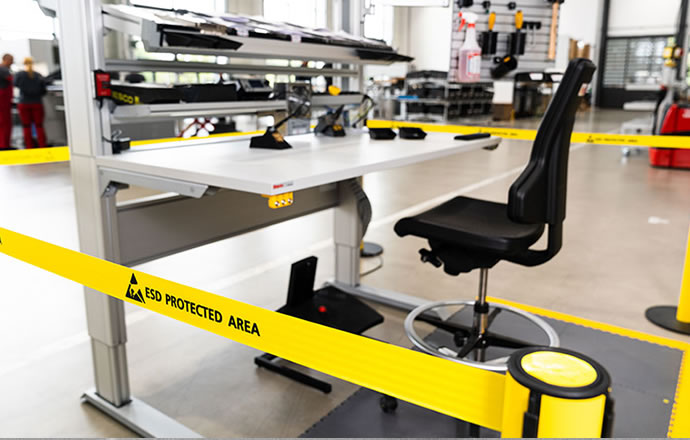
an epa (electrostatic protected area) is one of the basic essentials of effective esd safety.
There are a variety of components within an EPA that ensure ESD safety. For instance, an ESD Wristband protects people from electrostatic charges when connected to an ESD Earthing Terminal or ESD Earthing Plug via an ESD Connection Cable. What’s more, an ESD Table Mat, which is also connected to an Earthing Terminal or Plug, protects the components being used. When it comes to transporting goods, products such as item SystemMobiles are ideal, as they are in constant contact with the ESD flooring thanks to an ESD Drag Chain and can thus dissipate electrostatic charges. Although finding the right solutions doesn’t make ESD safety any less complex, it makes it relatively straightforward to implement – which is extremely worthwhile, not least because of its potential to help companies significantly reduce the failure rate of their products.
Interested in applications and solutions for ESD safety?
Then we have something that might just help!
Simply subscribe to the item blog by completing the box at the top right.
,
